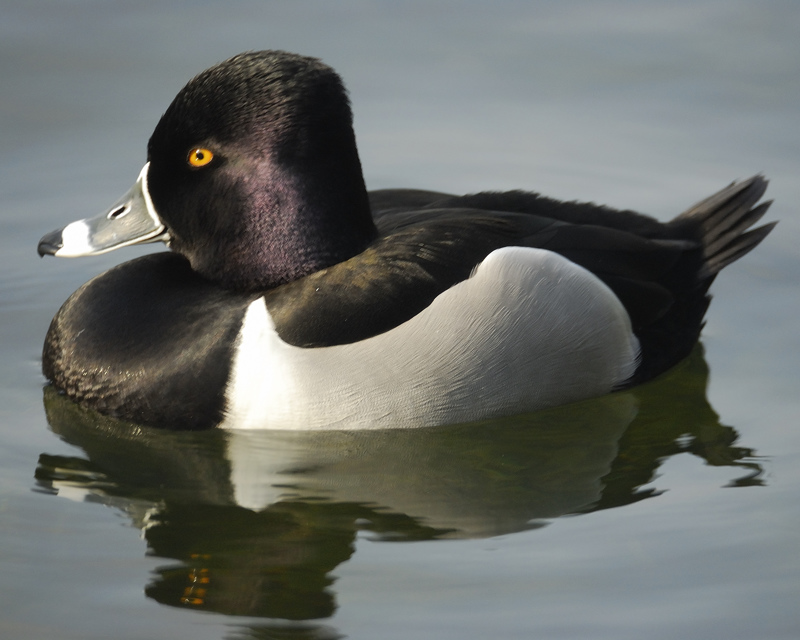
Ring-necked duck(Aythya collaris)
Phylum —chordata
Class — aves
Order — anseriformes
Family — anatidae
Genus –aythya
Appearance
Ring-necked ducks are small to medium in size. Males are slightly larger than females. Total length of males falls between 40 and 46 cm, and between 39 and 43 cm for females. The mass of males falls between 542 and 910 g and in females is usually between 490 and 894 g. Ring-necked ducks have a wingspan of 63.5 cm.
Defining characteristics of adult males include a black head, neck, breast, and upper portions, with a whitish gray belly and flanks. On the folded wing is a distinct white wedge on the shoulder that extends upwards. Adult females are grayish brown, with the darkest coloration on top of the head. They are pale on the front of their heads, chins, and throats. Eyes are bordered by a white ring, and females appear overall duller than males. The species is similar in profile to other diving ducks, but with a tail that is somewhat longer and a head that contains a short crest, which gives it its distinct peaked or angular appearance. Immature ducks appear similar to the adults, but are duller in coloration.
In the winter, adults and ducklings experience changes in physical appearance. The body mass of both increases, but adults show a more drastic change from their original mass.
Habitat
Ring-necked ducks are mainly a migratory species. During the breeding season, it can be found as far north as southern and central Alaska. Other populated portions of North America include the central Canadian regions as well as Minnesota, Maine, and some smaller portions of the northern United States. A few areas, including parts of Washington, Idaho, and other central western states of the United States are home to ring-necked ducks year-round. The species nests most often in the northern regions of Alberta, Saskatchewan, Minnesota, Wisconsin, Michigan, the central regions of Manitoba, and the southern regions of Ontario and Quebec.
These ducks prefer to spend their winters in the southern regions of New England and the Great Plains in the United States, the southern regions of British Columbia in Canada, and areas farther south including Mexico, Costa Rica, Jamaica, and Puerto Rico.
Behavior
Ring-necked ducks are a highly motile species that moves by walking, hopping, flying, swimming, and diving. It leaves the water to stand on floating objects for rest or comfort, and during nesting. The flight of this species is swift and flocks of twenty or less fly together in dense wedges. The duck can dive to depths of up to ten meters using foot propulsion. These ducks also perform self-maintenance in the form of preening, head-scratching, stretching, and bathing. While resting or sunbathing, the bird is found usually in calm, open water sheltered from the wind.
The hierarchy present within ring-necked ducks is as follows: Male adult dominant to female adult and adult dominant to immature duckling. There is no evidence of territoriality, but in open water a paired male defends a radius of 2 to 3 meters around his mate. The ducks are least social when they are paired off or while taking care of young. All females obtain a mate at the breeding ground but because of a skewed sex ratio, some males remain solitary and may choose to associate in small groups of 6 or less. During the non-breeding seasons, ring-necked ducks are usually associated with flocks of 40 birds or less. During migratory periods and winter, if food and resources are plentiful, flocks may reach greater than 10,000 individuals.
Ring-necked ducks can exhibit molting throughout the majority of the year. Molting is related to seasonal change, and is in preparation of the spring and fall migrations. Spring migration occurs from February to May, with peak levels during March and April. Fall migration occurs from September to December, with peak levels during October and November.
Diet
These birds are omnivores and feed mainly by diving or dabbling at the surface. Ducklings are dependent on animal matter such as insects, earthworms, leeches, midges and snails. As they mature they tend change their diet to submerged plants such as pondweed and coontail, and emergents such as annual wild rice and snails.
Reproduction
Ring-necked duck pairs start during spring migration. The pairs stay together only for reproduction, until then, they separate. The nest is bowl-shaped, built on water in dense emergent vegetation with sedges and woody plants. The female lays one egg per day until 8 to 10 eggs are laid. They are incubated 25–29 days and the female may remain with the young until they are able to fly.
The average lifespan is up to 15 years.
In captivity
The diet of these birds should include various kinds of leaves, water lilies, wild celery, wild rice, millet. It should also containmollusks, snails, nymphs, earthworms and leeches. Protein-rich food is important for birds during the reproduction season. During feeding, adult females eat almost only organic food.
In the paddock, it is necessary to maintain soil moisture. There must be arranged a reservoir with constantly replaced water.
 Russian
Russian
 English
English
























